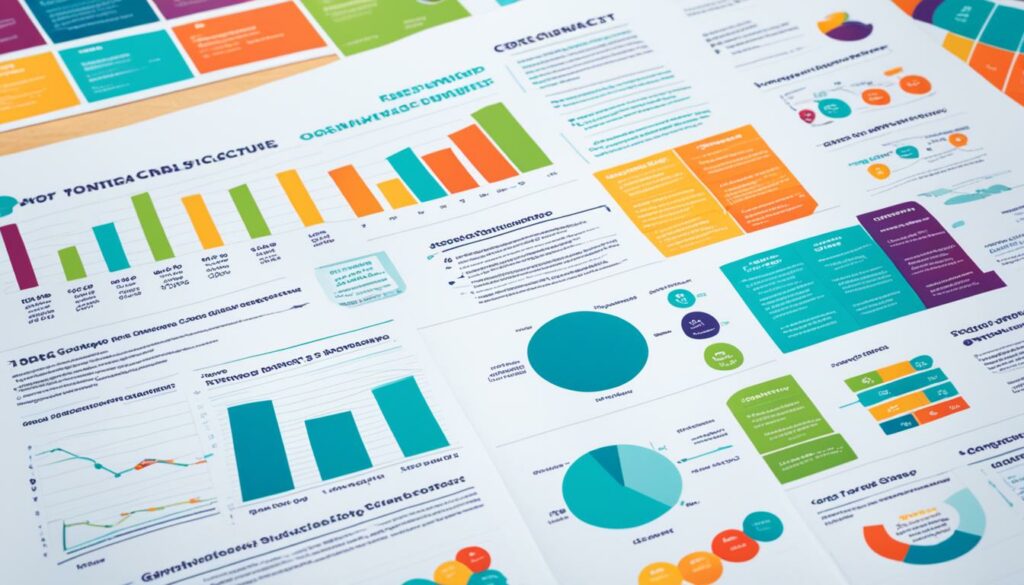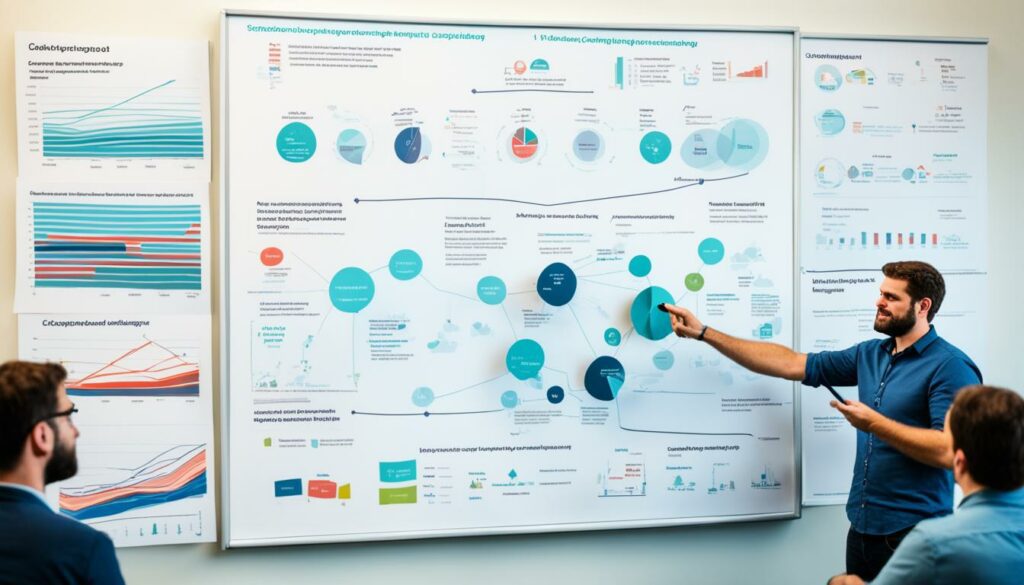Menu

Did you know that the worldwide impact investing market is valued at a massive $1.164 trillion? Government spending on social areas, philanthropy, and ESG investing adds up to a striking $72.05 trillion. These big numbers show how important market impact studies are. They help us see the wide effects of economic trends and understand how strategic choices influence businesses.
Market impact studies are key for smart decision-making. They show the effects of team efforts and help align marketing with business goals. For example, in the SaaS field, seeing more people sign up and pay for a service links back to good customer research. Keeping an eye on these links helps turn work into successful outcomes.
Companies like Buffer operate in a unique way, which affects how we measure success. They need special metrics because usual ones, like leads and win rates, don’t fit. This special need makes market impact studies especially important for understanding their success.
Market impact studies are key in judging how well business strategies work. They look at how different plans affect things like the economy and various industries. These studies rely on teamwork in a company. They focus on putting plans into action to see real results. It’s important to see how marketing affects business success. This is at the heart of good market studies.
To do a good market study, you need a solid plan. You start with things like customer research (inputs). These lead to creating strategies or sending newsletters (outputs). The goal is for these actions to help a business reach its big plans (outcomes).
Doing market research can show how to sell more and grow. It also helps keep an eye on what competitors are doing.
Looking at already existing info is a big part of these studies. This includes the state of the economy, where industries are heading, and new markets you could enter. Businesses use info from government stats, groups, and private groups. This data helps them make smarter choices. It also gives them a clearer view of what customers want, which is key for planning well.
Figuring out what people want from a product is really important. It’s key to know who these people are, like their ages and where they live. This helps shape how you talk to them about your product. You also need to know what other companies are doing. This tells you what’s already out there and what you can do differently. Knowing all this helps you set prices and choose how to promote your product.
Getting your hands on research doesn’t have to be super expensive. You can find useful facts and figures in lots of places, like universities and libraries. This is called secondary research. It’s cheaper and faster than getting the info directly from people (which is called primary research). Secondary research gives you a good overview of the market, customer details, and job trends.
At the end of the day, knowing what your customers like and need is crucial. It helps you decide where to set up shop, how much to charge, and how to sell. With the right info, companies can make smart moves. They stand a better chance in a competitive market.
Market impact studies are key for understanding different market forces and their full effect on the economy. They include several important parts that help companies plan their strategies well. Let’s look at these vital components.

Economic impact analysis looks at both direct and indirect effects on the economy. It checks the economic worth by looking at interest rates, GDP growth, and changes in rules. This helps stakeholders make smart decisions and handle risks correctly. Planning strategies wisely often starts with these detailed checks of the financial scene to understand the economic world better.
Industry analysis gives a full look at market trends, spotting strengths, weaknesses, and guessing where things are headed. It involves deep research into how markets work, how products are used, and trends. This lets businesses find areas where they need to grow or change. It also uses key measurements like the effects on prices, how well things can be bought or sold, and how much prices change, to really get the industry today and tomorrow.
Checking the competitive landscape helps businesses measure themselves against others to get useful market info. By comparing how well they and their competitors are doing, they spot opportunities and threats that are important for planning. This check helps them see where they’re placed compared to others and come up with plans to be more competitive.
| Impact Type | Description | Influence on Market |
|---|---|---|
| Liquidity Impact | Effect of trading activities on liquidity levels. | Higher transaction costs, price volatility. |
| Price Impact | Changes in asset prices due to market activities. | Asset price fluctuations. |
| Volatility Impact | Degree of price fluctuation over time. | Influenced by geopolitical tensions, economic data. |
After looking at the components, it’s clear that using things like economic impact analysis, industry analysis, and competitive landscape assessment together is vital. This approach makes sure we have a strong and full way to understand market forces and plan strategies well.
Market impact studies are key in showing how business activities affect the market. They aim to understand what customers like and to improve how loyal they are to a brand. These studies turn big plans into results we can measure, which can lead to big financial gains.
These studies help businesses reach key goals and show a clear path to success. For SaaS companies, this might mean getting more people to sign up, keeping customers longer, or using certain features more. They get important tips for making their marketing better, helping with choices, and using money wisely. By keeping an eye on the market and using research often, companies can win big.
Market impact studies show the journey from knowing what customers want (the start) to the strategies used (the end). But the real aim is the outcomes, which must match what the company wants. For example, the aim could be to not just get more subscribers but also to rank better in online searches for important words.
One big plus of these studies is that they spell out the market’s hidden profit opportunities and tell how customers act. They give businesses a strong base to understand the market better and use these lessons to grow and keep up with competition.
Also, doing these studies helps companies avoid risks in launching new products and keeps them flexible when the market is tough. By looking deeply at market trends and what customers do, companies make smart plans. This improves their financial situation, making them stronger in the market.
Conducting market impact studies is a methodical process. It requires several steps to get accurate insights. Businesses collect data in many ways to understand their markets better. They then use tools to analyse this data and predict what might happen next.

Starting with data collection is key in market studies. This step uses surveys, talking to customers, and watching the market. Services such as SurveyMonkey and methods like A/B testing help find out what customers like. It’s important to collect both numbers and stories to fully understand the market. It’s also crucial to be fair to avoid wrong results.
After collecting data, the next step is to analyse it using special tools and models. These can be software or stats models that spot patterns in data. It’s more important to look for trends than just single facts. Predictive models are used to guess what the market will do next. This helps companies make smart moves.
In short, studying market impacts involves careful steps from data collection to using special tools. Keeping an eye on trends is ongoing, helping companies adjust their strategies as needed.
Economic impact analysis is key for tracking shifts in revenue, profits, personal wages, and job numbers. It helps companies understand their overall economic influence. This study is critical for seeing how moves by these businesses affect the economy directly and indirectly.
To measure economic value, we look at changes in various economic markers. Important metrics are:
Understanding economic value helps firms connect their goals with real economic gains. I/O models like IMPLAN, RIMS-II, Chmura, Emsi, and aLocal Solutions help measure these factors well. They show how different business activities contribute to the economy, guiding smarter choices.
It’s vital to distinguish direct from indirect economic effects. Direct effects are the immediate changes caused by certain actions. This could be a fluctuation in revenue or creating jobs within a firm. In comparison, indirect effects are wider and might include more spending in the area or better economic mix in the region.
We also consider:
Looking at both direct and indirect effects gives a complete look at the impact. This way, companies can understand the wider consequences of their plans. AI tools, like aLocal’s, help by offering clear economic data from different areas.
By carefully breaking down these metrics through economic impact analysis, businesses can make choices that meet their financial goals.
Knowing what a market does well or struggles with is key in industry analysis. It uses tools like the Competitive Forces Model, PEST Analysis, and SWOT Analysis. The Competitive Forces Model looks at how fierce the industry competition is, new entrants, and supplier and buyer power. Along with checking trends, these help in planning.

PEST Analysis covers Political, Economic, Social, and Technological factors that affect businesses. It’s good for understanding market trends. SWOT Analysis focuses on what the business does well, lacks, the chances it has, and the dangers it might face. This gives a well-organized look at what a business is good at and what it needs to work on.
Steps to Conduct a SWOT Analysis:
Understanding and using market trends is vital. It’s about learning from how customers act, use products, and how rivals are positioned. This helps businesses to prepare for and respond to changes. Staying in step with the market helps them to keep up.
Guessing where the market is going involves pulling data from different analyses. Understanding new trends lets companies make smart choices for growth. when they are right, SaaS companies and others can lead the way. They make new moves that keep them successful for the long run.
For any business to do well in a changing market, knowing the competition is key. This means looking closely at other companies, seeing where you can do better or where you might fall short. It’s important to use tools like AI to really understand what’s going on. This way, you can be ready for new rivals and new tech trends.
It’s crucial to measure up against your competition. You compare how well your products or services are doing against others. By using tools such as the growth-share matrix, you can see if your offerings are leading the pack or not. This visual look at your position in the market is valuable.
Knowing the good spots to grow and the dangers is vital for success. Looking deeply at your strengths and weaknesses can show where to focus. It also helps to look at the big picture – like what’s happening in the economy or in tech. These insights guide better marketing and product plans. In the end, you see where to improve and what new ways you can reach customers.
| Competitor Type | Description | Key Characteristics |
|---|---|---|
| Primary | Companies selling the same product to the same target audience. | Direct competition, same market segment. |
| Secondary | Cater to different market needs and have varying marketing capabilities. | Different product focus, potential for cross-market appeal. |
| Replacement | Offer alternative products or services perceived as substitutes. | Indirect competition, fulfilling similar customer needs. |
| Future | May emerge leveraging new technologies. | Innovative market entries, potential disruptors. |
In brief, understanding the competitive landscape is a big advantage. It helps businesses handle the twists and turns of the market, find new chances and stay strong. Keeping an eye on the competition and being aware of threats can lead to steady growth.
Market opportunity evaluation is key for successful strategies. Understanding customer needs helps companies see where they can grow. By studying the market, they can find the best way to position their products.
It’s important to look at the competition too. This shows companies how they stand out and what they need to work on. Knowing all this helps make smart choices about where and how to sell their products.

Knowing where the market for a product or service is can help get funding. By showing how appealing their offerings are, companies can attract investors. They also learn how to balance risks and opportunities to reach their goals.
Looking at outside factors like laws, politics, and tech changes is also vital. It helps businesses make strong plans. With the right strategy, they can stand out and do well in the market.
This is useful for everyone, from new companies to big ones, and even non-profits. Regularly checking the market helps any organisation stay ahead. This leads to ongoing success and profit.
Market growth projections are crucial for making future plans in businesses. The global market is set to grow every year between 2023 and 2030. It shows a great future for companies wanting to grow.
Europe plays a big role in this, with a strong growth from 2022 to 2030. This growth highlights why companies should plan for Europe.
It’s important for businesses to look at key areas driving growth. These include retail, consumer goods, BFSI, and more. They show the many opportunities worldwide.
| Region | Key Growth Metric | 2023-2030 Projections |
|---|---|---|
| North America | US, Canada, Mexico | Significant CAGR growth |
| Europe | Germany, UK, France, Italy, Russia, Turkey | Magnificent growth in CAGR |
| Asia-Pacific | China, Japan, Korea, India, Australia, Indonesia, Thailand, Philippines, Malaysia, Vietnam | Diverse regional growth projections |
| South America | Brazil, Argentina, Columbia | Steady growth patterns |
| Middle East and Africa | Saudi Arabia, UAE, Egypt, Nigeria, South Africa | Emerging market potential |
Businesses should use financial planning to seize these upcoming opportunities. This approach helps companies make smart choices. It ensures they are ready to grow and stay strong.
Knowing what customers want is key for any brand. Salesforce says that understanding customer needs is crucial. They found that a big group, 63% of B2C and 76% of B2B, want brands to get them. That’s why tracking trends and using predictive models in marketing is so important today.
Studying consumer behaviour helps companies see what’s popular now and what might be next. This means their marketing can really hit home with people. A lot of business, about 65%, comes from loyal customers. Focusing on those who buy from you already has better success rates, like 60-70%. For new customers, the numbers are lower, 5-20%. So, understanding your audience well is a must.

Knowing why customers act the way they do is vital for marketing success. Most customers, two-thirds, want brands to listen to them more. And 62% think these companies should show they care about what people like. Understanding these desires is crucial for creating strategies that make customers happy. After all, 81% of people are more likely to buy if they’ve had a good experience.
Predictive models use lots of data to guess what customers might do next. They’re really important because one bad experience might send 61% of customers to a competitor. On the flip side, 60% would buy more from a brand that they feel looks after them. Adding these predictive models to your marketing means you can make customers happy before they even ask. This makes them more likely to stick with your brand over time.
By researching what customers do, watching trends, and using expert models, companies can get closer to their customers. This inspires loyalty and helps a business grow for the long haul.
Adding case studies to market impact studies shows how plans turn into wins. These stories tell of challenges, solutions, and results, sharing insights as they go. Let’s look at some success stories and the lessons learnt from them.
Case studies often bring detailed research and stats from customer feedback. Take HubSpot’s “How Handled Scaled from Zero to 121 Locations with the Help of HubSpot”, for example. It shows how Handled grew, showcasing products and services’ values with strong data.
“Rozum Robotics intensifies its PR game with Awario” is another good case. It uses a clear format with bullet points to share its market success. This way, it effectively tells its story and highlights the gains from strategic PR.
From these case studies, we learn key lessons for next time. IDEO’s “The Whole Package” is a great example. It simplifies challenges and solutions into easy parts, making it clear and interesting for readers.
Fractl’s “How Fractl Earned Links from 931 Unique Domains for Porch.com in a Single Year” shines with its visuals. The use of infographics and icons make data engaging and clear. Also, “Embracing first-party data: 3 success stories from HubSpot” has a neat, easy-to-read layout. This style makes the material easy to understand, showing the impact of their strategies.
| Case Study | Main Benefit | Key Lesson |
|---|---|---|
| HubSpot – Handled | Scaled to 121 Locations | Effective Use of HubSpot Tools |
| IDEO – The Whole Package | Simplicity in Information | Clear and Concise Presentation |
| Fractl – Porch.com | 931 Unique Domain Links | Visual Data Enhances Engagement |
| Think with Google – HubSpot | First-Party Data Use | Clean and Scannable Formats |
Market impact studies often run into difficulties because of data. Good data and lots of it are key for useful conclusions. But, many companies face problems getting the right data.
Data quality is a big issue. About a third think using better tech for data quality would help a lot. But, working with both kinds of data well is a challenge for under half of businesses.
Getting all the needed data is hard for many businesses. They’re busy with other things too, like 21% who say they have too many internal goals. Sometimes, there are also tech limits that make it tough to get the data they want.

Interpreting data once you’ve got it is another mountain to climb. Technology is crucial here, as seen by 77% who need it. But, one in five is held back by not having the right skills. This stops them from making sense of the data.
Dealing with complex data needs expert knowledge and the right tools. For instance, working with data from different cultures takes a special touch. Plus, making sure everyone, from home and abroad, understands the data can be hard. This often needs custom approaches to fit the market well.
Even though it’s a hard journey, they’re challenges that can be beaten. Doing so can bring about big changes for the better. It’s all about using the right tech and making sure people are trained well. This keeps the data work top-notch and the results meaningful.
Market impact studies are crucial for evaluating business effects on markets and economies. They help measure the difference between the market’s price and the price businesses pay. This info is vital for them.
Factors such as the size of an order, liquidity, and how quickly a trade happens affect market impact. Metrics like volume-weighted average price (VWAP) and arrival price show these impacts well.
The results of these studies are key for planning and managing resources well. For instance, breaking up big orders and trading when markets are liquid can reduce problems. VWAP and implementation shortfall are key tools for this analysis.
Thinking about these studies’ wider effects, they go beyond just one business. They also help understand the negative results of things like financial crises. With this info, companies can better tackle economic issues. This helps them aim for growth and lasting success.
Market impact studies look at how product marketing and strategies affect businesses. They measure outcomes that are hard to put a number on. This happens across different parts of the business.
They help us see how our business efforts are really doing. By understanding this, we can see if we’re meeting our goals. They also show us where to spend our money and effort wisely.
Market impact studies break down into a few parts. There’s the look at the economy, the industry, and what the competitors are up to. These parts help us understand the market better and plan our moves.
SaaS companies use a different approach. They look at unique sales processes and customer behaviour. This is because traditional sales measures don’t fit their model well.
This type of analysis focuses on the money side. It looks at direct earnings and the less obvious benefits, like creating jobs. It helps see the bigger picture of our efforts.
Researchers collect data in various ways. They use surveys, talk to customers, and watch the market. The aim is to gather all the important information.
To understand the data, experts turn to many tools and models. They use software to run analysis and make predictions. This helps in making smart decisions for the future.
Looking closely at the industry helps us know our market better. It looks at customer habits, trends, and what’s likely to happen next. This knowledge is vital for our business’s success.
This step compares our business to others. It aims to find where we can do better or what might block our way. Understanding this makes our position in the market clearer.
It’s about finding chances for new products or services. This looks at what people need and where there’s an opening. It guides our decision-making on where to focus our resources.
These forecasts are based on what we know about the market now. They guide our plans for growth and financial steps. With this insight, we can prepare for the future wisely.
This area studies how people interact with products and services. It uses models to predict what customers are looking for. These insights help shape our marketing moves to match people’s wants.
By showing real examples, case studies teach us a lot. We learn what works and what doesn’t from others’ experiences. These stories offer great lessons for our own strategies.
Getting good data and making sense of it all is hard. It needs a lot of skill and the right tools. But overcoming these challenges is key to making informed decisions.